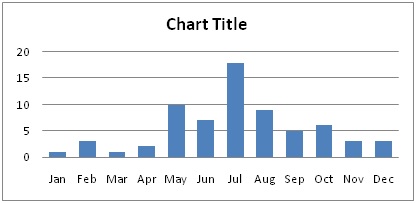Clinical profile and outcome of snake bite in children
Abstract
Background: Snake bite is generally considered to be a rural problem and has been linked with environmental and occupational condition is a neglected public health problem. This study was conducted to ascertain clinical profile, complication and outcome of snake bite in pediatric population.
Methods: Retrospective observational study was done in Paediatrics wards and Paediatric Intensive care unit of tertiary care institute. A medical record files of 200 patients of snakebite, between the periods of January 2013 to August 2018 were recovered from Medical Record and Statistics Section of Institute. Files were analyzed for demographic data; variables included site of bite, time of bite, type of primary treatment and treatment provider, and type of snake poison, common symptoms suggestive of hematotoxicity, myotoxicity and neurotoxicity.
Results: Out of total 200 patients, 59.0% were male and most of snake bites were seen in age group of 6-12 years. All bites were nonprovocative and in 57.5% lower limb was the commonest site of bite. A 81.5% patient were primarily treated by medical personnel, 56.5% patients were received treatment within 1 hour of bite and hospitalized within 6 hours of bite. Cellulitis was commonest complication (39.0%) followed by vasculotoxicity (30%) and neuroparalysis in (27.5%), followed by respiratory paralysis in (19.0%),coagulation (17.0%). Renal replacement therapy was required in 6.5%, blood/blood product transfusion in 11% patients and case fatality rate was 11.5%.
Conclusions: The most vulnerable to snake bites are boys aged more than 5 years. There is an urgent need to spread awareness among the community for avoidance of traditional treatment and any delay in medical intervention in snakebite incidents.
Downloads
References
2. Crompton DW, Peters P, editors. World Health Organisaton. Working to overcome the global impact of neglected tropical diseases. Geneva: Department for the Control of Neglected Tropical Diseases, WHO; 2010.p.172.
3. Crompton DW, editors. World Health Organization . Sustaining the drive to overcome the Global impact of neglected tropical diseases; Second WHO report on neglected tropical diseases. Geneva: department for the control of Neglected Tropical Diseases, WHO ; 2013.p.172.
4. Bhaumik S. Snakebite: a forgotten problem. BMJ. 2013 Jan 31;346:f628. doi: 10.1136/bmj.f628.[pubmed]
5. Kasturiratne A, Wickremasinghe AR, de Silva N, et al. The global burden of snakebite: a literature analysis and modelling based on regional estimates of envenoming and deaths. PLoS Med. 2008 Nov 4;5(11):e218. doi: 10.1371/journal.pmed.0050218.[pubmed]
6. Mohapatra B, Warrell DA, Suraweera W, et al. Snakebite mortality in India: a nationally representative mortality survey. PLoSNegl Trop Dis. 2011 Apr 12;5(4):e1018. doi: 10.1371/journal.pntd.0001018.[pubmed]
7. Hansdak SG, Lallar KS, Pokharel P, et al. A clinico-epidemiological study of snake bite in Nepal. Trop Doct. 1998 Oct;28(4):223-6. DOI:10.1177/004947559802800412
8. Warrell DA, Gutiérrez JM, Calvete JJ, et al. New approaches & technologies of venomics to meet the challenge of human envenoming by snakebites in India. Indian J Med Res. 2013;138:38-59.[pubmed]
9. World Health Organization. Rabies and Envenoming’s: A Neglected Public Health Issue.2007. [Last accessed on 2008 May 01; Last cited on 2014 Jul10]. Available from: http://www.who.int/bloodproducts/animal_sera/Rabies.pdf.
10. Bawaskar HS, Bawaskar PH. Envenoming by the common krait (Bungarus caeruleus) and Asian cobra (Najanaja): clinical manifestations and their management in a rural setting. Wilderness Environ Med. 2004 Winter;15(4):257-66.[pubmed]
11. Kumaravel KS, Ganesh J. A study on the clinical profile of children with snake envenomation in a tertiary referral centre at Dharmapuri, Tamilnadu, India. Int J Res Med Sci. 2016;4(6):2142-5.
12. Chandrashekar C, Shariff MA, Gopal K, Ravichander B. Clinical profile of snakebite in children. J Evidence Based Medi Healthcare. 2015;2(29):4176-84.
13. Krishana VM, Sheikh NA, Soren C. Clinical profile and outcome of snake bite envenomation in children: a retrospective study in a tertiary care centre KIMS Narketpally. Int J Information Res Rev. 2014;1(11):155-8.
14. Sani UM, Jiya NM, Ibitoye PK, Ahmad MM. Presentation and outcome of snake bite among children in Sokoto. North-western Nigeria. Sahel Med J. 2013;16(4):148-53.
15. Reddy MP, Sudharshan RC. Clinical, epidemiological and hematological profile of snake bite in children in rural teaching hospital. Int J Health Sci Res. 2015;5(7):58-63.
16. Lingayat AM, Wankhade PR. Study of clinical profile complications and outcome in patients of snake bite in pediatric age group. Int J Healthcare Biomed Res. 2015;3(3):203-8.
17. Digra S, Singh V. A clinical profile of neurotoxic snakebite in pediatric population of Jammu region. JK Sci. 2016;18(2):67-70.
18. Chew KS, Khor HW, Ahmad R, Rahman H. A five year retrospective review of snakebite patients admitted to a tertiary university hospital in Malaysia. Int J Emerg Med. 2011;4:41.
19. Wang JD, Tsan YT, Chiao M, Wang LM. Venomous snakebites and antivenom treatment according to a protocol for pediatric patients in Taiwan. J Venom Anim Toxins Incl Trop Dis. 2009;15(4):667-79.
20. Paudel KM, Poudyl VP, Rayamajhi RB, Budhathoki SS. Clinico-epidemiological profile and outcome of poisonous snake bites in children using the WHO treatment protocol in western Nepal. J Nobel Medical College. 2016;4(7):21-5.
21. Chinchorlikar SV, Patniak B, Raje S. Awareness of snake bite and its first aid management in rural areas of Maharashtra. Indian J Community Health. 2014;26(3):311-5.
22. Gautam P, Sharma N, Sharma M, et al. Clinical and demographic profile of snake envenomation in Himachal Pradesh, India. Indian Pediatr. 2014 Nov;51(11):934-5.[pubmed]
23. Adhisivam B, Mahadevan S. Snakebite envenomation in India: a rural medical emergency. Indian Pediatr. 2006 Jun;43(6):553-4.[pubmed]

Copyright (c) 2019 Author (s). Published by Siddharth Health Research and Social Welfare Society

This work is licensed under a Creative Commons Attribution 4.0 International License.


 OAI - Open Archives Initiative
OAI - Open Archives Initiative


